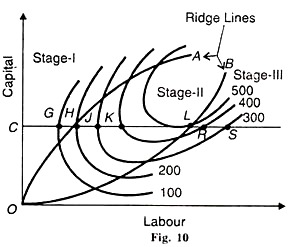Notes on The Law of Variable Proportions!
The behaviour of the law of variable proportions or of the short-run production function when one factor is constant and the other variable, can also be explained in terms of the isoquant analysis. Suppose capital is a fixed factor and labour is a variable factor In Figure. 10.
OA and OB are the ridge lines and it is in between them that economically feasible units of labour and capital can be employed to produce 100, 200, 300, 400 and 500 units of output. It implies that in these portions of the isoquants, the marginal product of labour and capital is positive.
ADVERTISEMENTS:
On the other hand, where these ridge lines cut the isoquants, the marginal product of the inputs is zero. For instance, at point H the marginal product of capital is zero, and at point L the marginal product of labour is zero. The portion of the isoquant that lies outside the ridge lines, the marginal product of that factor is negative. For instance, the marginal product of capital is negative at G and that of labour at R.
The law of variable proportions says that, given the technique of production, the application of more and more units of a variable factor, say labour, to a fixed factor, say capital, will, until a certain point is reached, yield more than proportional increases in output, and thereafter less than proportional increases in output. Since the law refers to increases in output, it relates to the marginal product.
To explain the law, capital is taken as a fixed factor and labour as a variable factor. The isoquants show different levels of output in the figure. ОС is the fixed quantity of capital which therefore forms a horizontal line CD. As we move from С to D towards the right on this line, the different points show the effects of the combinations of successively increasing quantities of labour with fixed quantity of capital ОС.
To begin with, as we move from С to G to H, it shows the first stage of increasing marginal returns of the law of variable proportions. When CG labour is employed with ОС capital, output is 100. To produce 200 units of output, labour is increased by GH while the amount of capital is fixed at ОС.
ADVERTISEMENTS:
The output has doubled but the amount of labour employed has not increased proportionately. It may be observed that GH < CG which means that smaller additions to the labour force have led to equal increment in output. Thus С to Я is the first stage of the law of variable proportions in which the marginal product increases because output per unit of labour increases as more output is produced.
The second stage of the law of variable proportions is the portion of the isoquants which lies in between the two ridge lines OA and OB. It is the stage of diminishing marginal returns between points H and L. As more labour is employed, output increases less than proportionately to the increase in the labour employed.
To raise output to 300 units from 200 units, HJ labour is employed. Further, JK quantity of labour is required to raise output from 300 to 400 and KL of labour to raise output from 400 to 500.
So, to increase output by 100 units successively, more and more units of the variable factor (labour) are required to be applied along with the fixed factor (capital), that is KL>JK>HJ. It implies that the marginal product of labour continues to decline with the employment of larger quantities to it.
ADVERTISEMENTS:
Thus as we more from point II to К , the effect of increasing the units of labour is that output per unit of labour diminishes as more output is produced. This is known as the stage of diminishing returns.
If labour is employed further, we are outside the lower ridge line OB and enter the third stage of the law of variable proportions. In this region which lies beyond the ridge line OB there is too much of the variable factor (labour) in relation to the fixed factor (capital).
Labour is thus being overworked and its marginal product is negative. In other words, when the quantity of labour is in-cased by LR and RS the output declines from 500 to 400 and to 300. This is the stage of negative marginal returns.
We arrive at the conclusion that a firm will find it profitable to produce only in the second stage of the law of variable proportions for it will be uneconomical to produce in the regions to the left or right of the ridge lines which form the first stage and the third stage of the law respectively.
